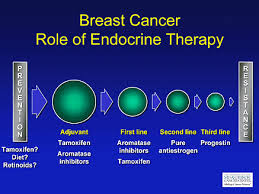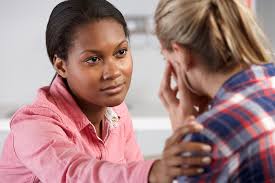Applying Endocrine Therapy for Breast Cancer Treatment
Applying Endocrine Therapy for Breast Cancer Treatment: Not everyone is Eligible for Endocrine Therapy

Applying Endocrine Therapy for Breast Cancer Treatment is one of the best treatment methods available today.
The treatment of cancer is one that makes so many people to panic in fear. Owing to the dangers associated with this disease people are often very worried of the outcomes of the treatment even as they hope for the best. We enquired from the experts at AWAREmed Health and Wellness Resource Center and doctor Dalal Akoury shared with us very useful information about endocrine therapy as a treatment option. Doctor Akoury who is also the CEO of this facility says that in applying endocrine therapy for breast cancer treatment careful attention should be taken not to confuse the hormones. There are certain hormones that can attach to breast cancer cells and affect their ability to multiply. The purpose of endocrine therapy, formerly called hormone therapy, is to add, block, or remove hormones. Doctor Akoury continues that with breast cancer, the female hormones estrogen and progesterone can promote the growth of some breast cancer cells. Therefore in some patients, endocrine therapy is given to block the body’s naturally occurring estrogen to slow or stop the cancer’s growth. There are two types of hormone therapy for breast cancer.
- Drugs that prevent estrogen and progesterone from promoting breast cancer cell growth.
- Drugs or surgery to turn off the production of hormones from the ovaries.
Take note, not to be confused between the hormone therapies applicable in treating women with breast cancer to that hormone replacement therapy that is typically used by postmenopausal women.
- Hormone therapy for cancer treatment also known as endocrine therapy stops hormones from getting to breast cancer cells.
- Hormone therapy for postmenopausal women without cancer called which is known as hormone replacement therapy adds more hormones to your body to counter the effects of menopause.
Applying Endocrine Therapy for Breast Cancer Treatment: Who can Get Endocrine Therapy for Breast Cancer
As part of the diagnosis process, tests are done to determine if the breast cancer cells have estrogen or progesterone receptors. If so, that means that growth of the cancer can be stimulated with these hormones. If a cancer is found to have these receptors, endocrine therapy is recommended as part of the treatment plan.
Applying Endocrine Therapy for Breast Cancer Treatment: Hormone Therapy Drugs Used for Breast Cancer
We have several common hormone therapy drugs used for breast cancer and they may include the following:
- Tamoxifen
- Arimidex
- Aromasin
- Femara
- Zoladex/Lupron
- Megace
Applying Endocrine Therapy for Breast Cancer Treatment: Breast Cancer and Tamoxifen
This pill has been used for over three decades now in treating breast cancer. Originally it was first used in metastatic breast cancer (cancer that spread) because it decelerate the development of cancer cells in the body. Tamoxifen also decreases the chance that some early-stage breast cancers will recur in premenopausal or post-menopausal women and it can reduce the risk of cancer developing in the unaffected breast. Besides that, it may offer an alternative to watchful waiting or prophylactic (preventative) mastectomy for women at high risk for developing breast cancer.
Tamoxifen is a type of drug called a selective estrogen-receptor modulator (SERM). At the breast, it functions as an anti-estrogen. Estrogen promotes the growth of breast cancer cells. Tamoxifen blocks estrogen from attaching to estrogen receptors on these cells. By doing this, it is believed that the growth of the breast cancer cells will be halted. Tamoxifen can also be considered as an option for the following cases:
- Treatment of ductal carcinoma in situ (DCIS) along with breast-sparing surgery or mastectomy.
- Adjuvant treatment of lobular carcinoma in situ (LCIS) to reduce the risk of developing more advanced breast cancer.
- Adjuvant treatment of breast cancer in men and women whose cancers are estrogen-receptor positive.
- Treatment of recurrent and metastatic breast cancer.
- To prevent breast cancer in women at high risk for developing the disease.
Even though Tamoxifen is useful in cancer treatment, it is not applicable to everyone. The following people should not use tamoxifen:
- Pregnant women
- Women planning to become pregnant
- Men or women with a history of blood clots or stroke
If the three points describe you then before considering this treatment mode, you will need to talk to your doctor to see if tamoxifen is right for you. Nevertheless as for women, the side effects of tamoxifen are similar to some of the symptoms of menopause. Two of the most common side effects are hot flashes and vaginal discharge. Other tamoxifen side effects in women may include:
- Vaginal dryness or itching
- Irregular menstrual periods
- Headache
- Nausea or vomiting
- Skin rash
- Fatigue
- Fluid retention or weight gain
While some of its side effects are similar to menopausal symptoms, tamoxifen does not trigger or cause menopause in women. It’s (Tamoxifen) side effects in men may include:
- Headache
- Nausea or vomiting
- Skin rash
- Sexual side effects including impotence or decrease in sexual interest
While applying endocrine therapy for breast cancer treatment the question that many would be asking would be, “are there some risks involve for those people taking tamoxifen for treatment?” this is a valid concern, doctor Dalal Akoury agrees. In her response she gives a resounding YES. Therefore the following are some of the known risks involved when taking tamoxifen:
- Fertility – Tamoxifen may affect fertility, so it is important to use some form of barrier birth control while you are taking it. However, do not use oral contraceptives like the pill since they may change the effects of tamoxifen and affect the breast cancer. Tell your doctor right away if you think you may have become pregnant while taking this medication.
- Increased blood clots – Women taking tamoxifen may have a slightly increased risk of developing blood clots in the lungs or large veins. This risk is increased in smokers.
- Increased risk of stroke
- Uterine cancer/sarcoma – Tamoxifen may increase a woman’s risk of developing uterine cancer (cancer of the lining of the uterus) or uterine sarcoma. However, this risk is very small and needs to be balanced against the significant benefits of taking tamoxifen for breast cancer.
- Cataracts – Taking tamoxifen appears to put some women at increased risk for developing cataracts, a clouding of the lens inside the eye. People have also reported eye problems such as corneal scarring or retinal changes.
- Medications – Tamoxifen may affect the metabolism of other drugs.
Applying Endocrine Therapy for Breast Cancer Treatment: Tamoxifen and Breast Cancer Prevention
Over the years efforts has been made by different researchers with an objective of establishing whether tamoxifen would reduce the occurrence of breast cancer in healthy women known to be at high risk. The outcome of the trials indicated a 50% reduction in both invasive and non-invasive breast cancer in the women treated with tamoxifen. Besides that, tamoxifen has also been shown to significantly reduce the risk of developing invasive breast cancer in women who have had ductal carcinoma in situ (DCIS). We may not be able to exhaust everything in this article and I want to introduce you to the expert for further consultation. You can schedule for an appointment with doctor Akoury for all the concerns you may have about applying endocrine therapy for breast cancer treatment.
Applying Endocrine Therapy for Breast Cancer Treatment: Not everyone is Eligible for Endocrine Therapy




